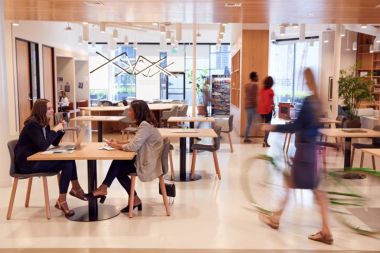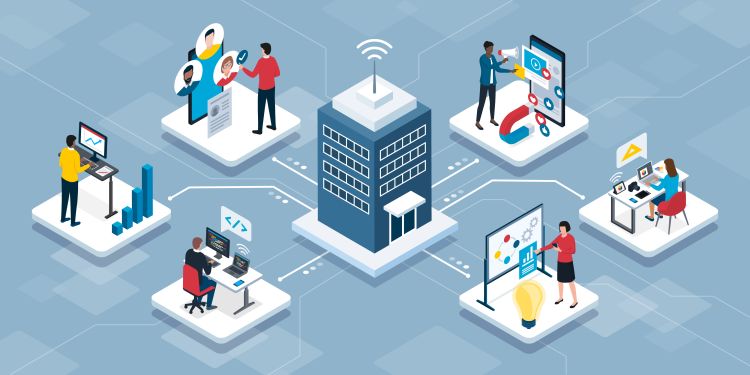The office revisited
There has been lots of talk around Covid and the ‘new normal’, but what will the ‘new office’ look like once we get out of the pandemic? Paul Milligan canvases opinion from the industry.

(pic:shutterstock Monkey Business Images)
Endless column inches have been filled in the last 12 months on the ‘new normal’. The ability of the human race to adapt to new surroundings and scenarios has been stretched to extremes in the last year. During the Covid pandemic, we’ve all shifted from a generation of nine to five deskbound office workers to working from home en masse.
Now that vaccines are being administered globally, much discussion has begun centering on the return to work and what exact form that will actually take. In the ‘new normal’ what will the ‘new office’ look like? Are we equipped for Bring Your Own Meeting? And could the business model of how the AV industry supplies its services to clients change?
We spoke to a cross-section of the AV industry to see where consensus lies.
What will users expect from the office experience once the pandemic is no longer an issue? “People want something that feels comfortable and familiar as the office experience now needs to compete with the personalised nature of a home environment,” says Rory Brannigan, CEO from systems integrator IDSM. “People expect spaces that easily lend themselves to collaboration. Some people like to stand in meetings, others to sit. Some people prefer to stand up and use a collaboration board, while others prefer the structure of a sit-down meeting. AV needs to cater to a broad spectrum of users, to ensure that the success of adoption in a home environment carries on into the office.”
The comparison between home and the office was brought into sharp focus for many of us in the last 12 months because the home became the office.
Just because we designed and installed working environments one particular way pre-Covid, doesn’t mean we have to go back to that method says Greg Jeffreys, director of Visual Displays, in fact far from it. “In doing all these Zoom meetings we’ve realised a lot of the face-to-face meetings we used to have weren’t essential. The actual issue is more about what meetings are for and how they’re conducted. I think that a lot of the stuff we’ve put in meeting rooms is fat-ware, we’ve put €10,000 touch panels on tables, most people at home control everything off their phone in a much more intuitive way. There is growing momentum about how we build and design meeting rooms, and the whole ecosystem around very heavily engineered environments.”
The future of the office post-Covid is more likely to be a bespoke, flexible, technology hybrid model rather than a prescribed, one-size-fits-all design. “Employers understand that flexible and hybrid working is now here to stay but need to continue to attract their staff into the office to ensure they don’t lose some of the ‘water-cooler’ innovation that takes place ad hoc through natural collision,” says Gavin Fletcher, chief marketing officer for workplace design company UMA. “Employers and employees appear to be developing an unwritten contract around this and in exchange for that flexibility employers can look to potentially reduce or repurpose real estate, allowing them to perhaps reinvest in collaboration environments ensuring parity in meeting experience between the remote worker and those in the office.”

(pic: shutterstock/elenabsl)
The hybrid approach seems to be something everyone can agree on, the March 2021 issue raised that meetings will simultaneously cater for staff in the room and for those at home, and the experience has to be the same no matter where they are. With this hybrid approach comes the opportunity for new products and new meeting room/office designs to come the fore says Tony McCool, head of interactive and collaborative solutions pro-AV, from distributor Exertis. Among those being that technology must be able to be picked up and used instantly. “Users want solutions that enable them to use rooms in a truly obvious way. In other words, they don’t need ‘training’. Whilst some familiarisation is expected it could be deemed that a solution is too complex if it needs an hour to learn it.”
The old model of office life was you went to work every day and sat at the same desk and used the same PC as everyone else. Thanks in part to Covid, but also societal shifts and technological advancements all that has changed. Whilst this was happening, we’ve also morphed from Bring Your Own Device to Bring Your Own Meeting.
The desire now is for meetings with in-room and remote participants with no compromise in audio or video quality, where documents can be uploaded, moved, edited and saved by individuals no matter where they are in the world. And they can be held anywhere, not just in a dedicated meeting room. Is the AV industry meeting these challenges or is playing catch-up? “I believe it’s a constantly evolving thing. It’s a balancing act of ensuring relevant security protocols are being adhered to, while acknowledging that people should be given the flexibility to use what feels comfortable for them and allows them to be productive,” says Brannigan. “People are going through their own period of introspection and discovery when it comes to AV collaboration, this fuel can be used to fire up digital transformation within an organisation and AV companies need to respond to this.”
Covid may be driving seismic change within the office environment, but not all of those changes will last the test of time believes Adam Carson, head of external sales pro-AV, from distributor Exertis. “I think it’s potentially short-sighted to assume that all the enforced changes throughout the pandemic will become the new norm. The population has been forced into a more isolated setting, yet the requirements of the working population have not diminished. You only have to look at how people respond to the little bits of freedom allowed through government transition to see that people are longing for the social aspect of both sides of the work-life balance to return. BYOM will be a continued investment platform across all sectors, but I wouldn’t expect face-to-face engagement to be something that is forgotten.”
While the exact makeup of offices may be up for debate, one aspect that is here to stayis the importance of UX design philosophies. No matter what technology is installed in the future, it has to be designed with the user in mind and has to be as easy to use as humanly possible. We must remember end users are not always technically-minded says Stephen Sevastopulo, COO and co-founder at Collaboration Squared. “There’s a difference in technical ability between people who look at technology and deal with it all the time and will put something in a room that looks beautiful. And then someone comes in who isn’t necessarily so technical and they’re lost. From a user experience point of view, one-button-to-push technology is really going to come to the fore and simplify what we do as an industry in terms of joining meetings.”
Another aspect of office life that is going to change in the future is how clients pay for AV. The IT industry has run on a service model for decades, and it is something that is starting to pick up momentum in the AV world. The provision of AV in corporate spaces is likely to be increasingly dominated by services, but if the user experience delivered is not positive the user will simply switch service, so what will this do to the AV sector? It will ensure the industry is kept on its toes says Brannigan, but also helps to bring UX into play; “The days of large scale capital expenditure are coming to an end for the most part, and UX and the service model are inextricably linked. If you don’t have customer success teams, continually ensuring that the users are getting value and a positive experience from your systems there will be someone right behind you waiting to eat your lunch with their solution in hand. The cumbersome headache to switch from one to the other is largely gone, and solution providers need to wake up to this.”
Greg Jeffreys is in complete agreement, “I think it represents a specific opportunity for UX. Because the idea that you’re continually making rolling changes of kit does allow better engagement with users. It’s actually less about spending money and more about finding the most appropriate things.” Finally, it would be a missed opportunity in the ‘new office’ to not take advantage of all the data that’s created around us says Fletcher: “At UMA we are building in qualitative feedback in a TripAdvisor model to capture user experience of meeting rooms including environmental and technology-specific feedback loops. This data, when combined with the data extrapolated from BMS or AV equipment or IoT occupancy or environmental sensors, provides a holistic set of business intelligence that can provide the actionable insight that today’s smart workplace really needs.”
Taken from Inavate. 29 April 2021.
Visit the Inavate website for more information.
Posted: 14th May 2021